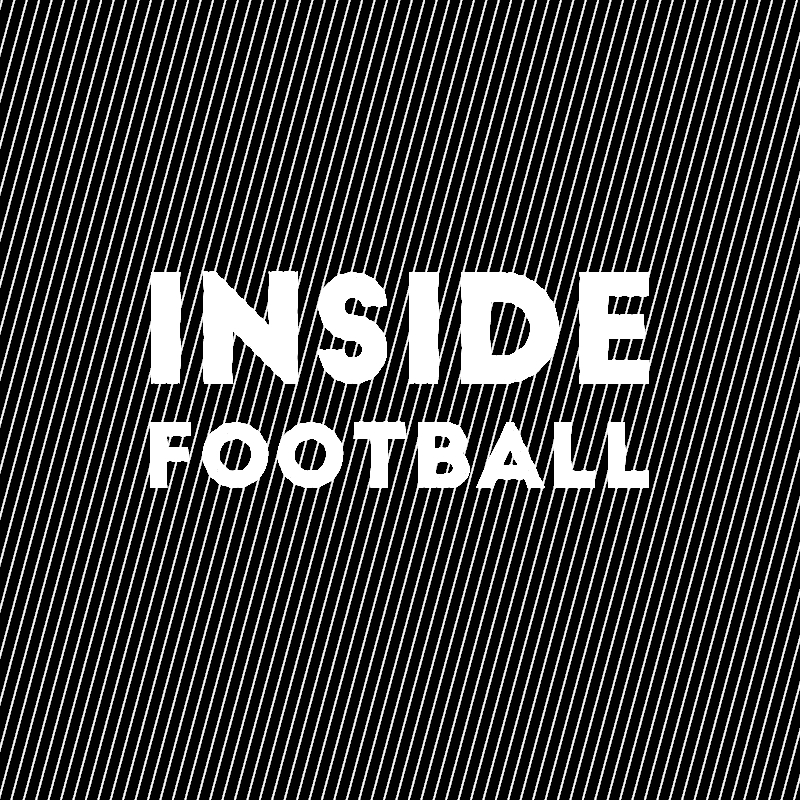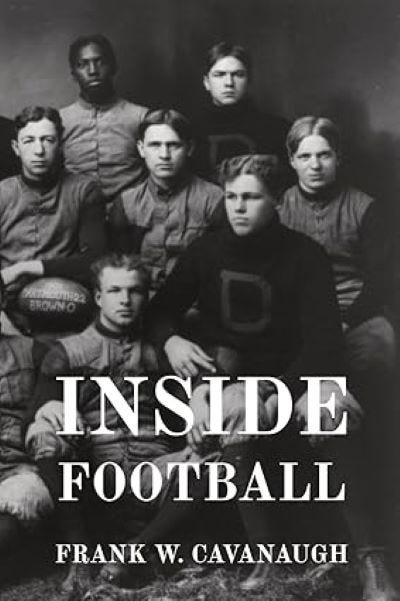Coach Frank W. Cavanaugh
Francis William Cavanaugh was an American football coach of the old school. He was born in Worcester, Massachusetts on April 28th, 1876, to Patrick Cavanaugh and Ann O’Brien Cavanaugh, both Irish immigrants. A star football player in high school, Cavanaugh later attended Dartmouth where he continued to excel at the game. In 1898 Cavanaugh left Dartmouth to accept a job at the University of Cincinnati, the first in a series of increasingly successful coaching positions he would hold until his untimely death in 1933.
Cavanaugh’s life and career were depicted in the 1943 Hollywood film, “The Iron Major,” starring the popular 20th century Irish-American actor Pat O’Brien in the title role. Coach Frank W. Cavanaugh was inducted into the College Football Hall of Fame in 1954.
Long and Short Forward Passes
As a rule, forward passes from a set formation are much less effective than those thrown unexpectedly from a running formation, with the defensive backs already on their way to protect the spot threatened by the supposed run. Under the latter condition, coaches and players can figure to a nicety the probable position of the secondary defense at the time the pass is to be thrown. This greatly lessens the chance of interception, even when the thrower’s accuracy is only moderate.
The one general law regarding forward passes is to throw them when possible ahead of the runner as he is facing. He is surer of the ball and surer of an additional gain if he can field the ball while in motion. However, the pass, if particularly quick, must be thrown accurately to the receiver. Short forward passes can be thrown equally well by any man in the backfield, if five yards behind the line, assuming equal proficiency among the backs; but many of the very effective long passes are thrown to best advantage by the quarterback behind the deception of a fake running attack. Other deceptions such as double or triple passing may be employed to give the eligible receivers time to get down the field. Or the long passing may depend for execution upon the original deep backfield position of the thrower, as in a kick formation. Placement kick formations provide a particularly effective mask for forward passing intention.
The forward pass may be said to have accomplished its original mission in football. That was to keep the defense sufficiently open and sufficiently in a state of uncertainty to render it possible to make ground consistently by running attack. Even when the pass is only used as a threat, its primary purpose appears to have been achieved. In fact, it may be questioned whether the rule-makers have not gone a little farther than they really intended. They have given the offense a weapon with which, when expertly used, no defense can cope. Almost any coach can devise forward pass plays against which there is literally no protection which will not weaken beyond hope the scrimmage defense of the team attacked. Fortunately, the human equation enters in to save the situation.
The forward pass is a great disorganizer of a team which is excellent against straight attack. This team is often tight against the strongest plays at or around the tackles; but let two successful forward passes be thrown, or even one, and the effect on scrimmage defense is often surprising. Unless the pass is restricted, offense will incline, I think, to its use more and more. There are many possibilities in the way of forward passes completed behind the line of scrimmage which have not been realized. As a team could gain consistently were it not for the defensive quarter, evidently forward passes directed behind his position will continue to have at least a fifty-fifty chance of success, and against long passes there is really no adequate defense that will not hopelessly weaken the defense against running attack.
It is a mistake to grip the ball in making long forward passes. In bringing the ball sharply around in the act of throwing there is sufficient resistance to give control and to impart the necessary spiral twist, provided the three longer fingers are firm on the part of the lacing nearest to the end of the ball, which is balanced on the palm and thumb. But while drawing the ball back behind the ear, where it is held pointing toward the right and rear (in the case of a right-handed thrower), the left hand is used to press it firmly against the right hand, and this pressure is relinquished only in the act of throwing. The ball is really thrown sideways, but as the thrower’s arm completes the arc which points the projectile in the direction intended, he twangs the lacing as he snaps his wrist, thus imparting a definite rotary motion to the ball.
Long passes should never be made to the runner, but into a zone beyond and preferably inside of the runner in the general direction of his flight when the ball is thrown. When he changes direction to field the ball he will be able to see it by a slight turn of the head without loss of speed.
He may also discover any special danger of interception.
Some of the best long forward passes I have used start apparently as cross-tackle bucks, with the quarter under center.
The backs give every appearance of making a genuine line play. They charge the end and tackle, while their tackle takes the guard. The quarter, having faked his pass to one of the backs, hustles to a point five yards behind the tackle, taking advantage of the backfield’s protection. He makes his spiral pass to either end, although the more diagonal pass is the easier to recover.
The ends have gone down the field in a wide course, in order to run past and around the defensive halfbacks. The latter are forced to make their turn inside of the ends, who when twenty yards down the field are some fifteen yards outside of the halfbacks’ original positions. These backs are never able to field a pass of sufficient carrying power, or even to overtake the runner, provided the latter is not compelled to wait for the ball; the ends being fairly on top of them by the time the ball is in the air. The end is going at full speed, and with perfect assurance, to a zone known to him and unknown to his opponent.
A pass carrying twenty-five yards beyond the line of scrimmage cannot be fielded, in fact, by either the halfback or the fullback. This statement might be incorrect in case the fullback makes an immediate guess as to which of the ends will receive the ball. If he backs the wrong guess, a touchdown results. If the ball is thrown poorly, too near to the center of the field, the full back may recover it; or he might have a fair chance to field the ball if he were playing closer to the line of scrimmage than he ought; in which event the quarterback would no doubt have elected the surprise kick instead of the forward pass. As the ends are at least fifteen and often twenty yards down the field before the fullback can be certain of the direction of the ball, and as they are in motion while the fullback is not, the latter’s chances to interfere with passes up to forty yards in length have practically the value of a zero from which even the cipher has been eliminated.
The receiver can watch the ball and the halfback while running, while the halfback must lose sight of the receiver if he turns to look for the ball. So that the advantage remains with the attack, even if the pass is a trifle short. Of course, if the pass is altogether too short, the halfback may be expected to get it. There might be such a thing as a pass too short even for the halfback. But the problem of getting distance is generally the least of the passer’s worries. The ball has only to be thrown with sufficient height to “stay up.” The great difficulty is to find ends who will run and not lag, and who will field the ball as an outfielder in baseball fields the drive over his head.
Covering the last fifteen yards with arms outstretched has cost many a receiver many a pass.
His first duty should be to get under the ball. The best ends let the ball come to them, have a neat basket of hand, chest and forearms ready for its reception, and continue the run without losing a stride. They have timed their speed to effect a perfect junction with the arrival of the ball.
Another very dangerous pass is thrown behind the deception of a center buck, on which it depends, in fact, as the defensive quarter must be drawn into the line. The tandem forming on the left, the quarter fakes his pass while swinging around to his left foot. He must remember to point his left toe sharply at a right angle to the scrimmage line, as his next move is to take a long step with his right foot, another with his left and another with his right, which swings him into position for his throw. The pass is taken six to ten yards over center by either of the ends, one long, one short. The ends time the pass, and the one certain of his ability to make connections hails the other with the familiar “I’ve got it,” or “I have it,” of baseball. The other end, relieved of his responsibility for the pass, turns his attention instantly to the nearer defensive halfback, and prepares the way for a run.
Preliminary to both of these pass plays the ends show every intention of nailing the defensive tackles, as usual, but as the latter, no less than the defensive quarter, have every reason to expect a line play, they will, if necessary, throw the ends down the field, rather than attempt to impede their getaway. There are many other passes, and they all place a tremendous burden upon the secondary defense. It must know the combination of both defenses, against running plays and against passing. If passes are used continually, the defense will set itself for them; but too often the tendency will be to play the halfbacks too far back or the fullback too far up.
Order Full Text
We hope you have enjoyed this excerpt from Inside Football by Frank W. Cavanaugh, published in 2023 by Ether Editions. Inside Football is available from Major Online Retailers.







